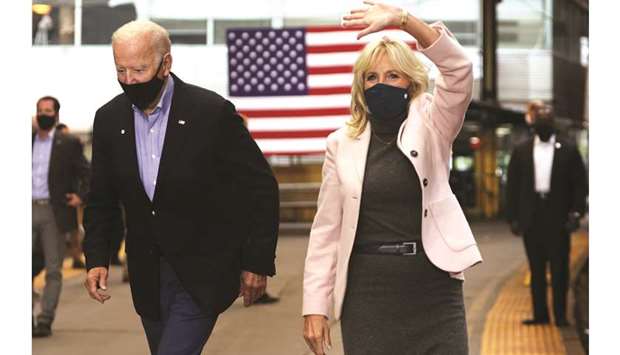With a shout-out to the Proud Boys militia, President Donald Trump has once again shown a readiness to court right-wing extremists as he battles for re-election.
During a caustic debate with election rival Joe Biden on Tuesday, Trump lashed out at the leftist Antifa movement and other participants in sometimes violent protests against police abuse and racism over the past several months.
Asked whether he would likewise condemn armed right-wing and white supremacist groups — specifically the Proud Boys, who have violently confronted leftist protesters in Portland, Oregon and elsewhere — Trump at first said “sure” but then demurred.
“Almost everything I see is from the left-wing, not from the right-wing,” Trump said. “Proud Boys, stand back and stand by,” he continued.
“I’ll tell you what, somebody’s got to do something about Antifa and the left, because this is not a right-wing problem. This is a left-wing problem.”
Trump recanted yesterday following an intense backlash, denying any knowledge of the Proud Boys and calling on right-wing militias to “stand down” and let police “do their work.”
But his campaign will worry that the clean-up did little to mitigate the impression that Tuesday’s rhetoric left on moderate, undecided voters.
His original comments were widely taken as an endorsement of the Proud Boys and other groups who, often heavily armed, have squared up to Black Lives Matter and Antifa activists around the country, as well as joining protests against public health measures for the coronavirus.
The Proud Boys themselves celebrated Trump’s comments.
“Standing down and standing by sir,” the group said in a social media posting.
“President Trump told the proud boys to stand by because someone needs to deal with Antifa...well sir! we’re ready!!” said Joe Biggs, a Proud Boys organiser, wrote on Parler, the Twitter-like social media that does not block extremists.
It was the latest in a long series of exchanges that have been interpreted as tacit endorsements by Trump of right-wing extremists, and the first that appeared to offer specific direction, despite the FBI having warned that they pose a greater domestic terror threat than any other group.
The president’s soft approach to the far right first came to light in August 2017 when neo-Nazis, white power advocates and other extreme nationalists, including the Proud Boys, joined hands in a Unite The Right rally in Charlottesville, Virginia.
After violence broke out with counter-protesters, which saw one neo-Nazi kill a woman as he drove his car into a crowd, Trump declined to offer an unequivocal condemnation of the right-wing groups.
Instead, he famously commented, there were “very fine people on both sides.”
In 2019, Richard Spencer, who organised Unite the Right, told US magazine The Atlantic that Trump becoming president had made it possible for the extreme right to emerge from the shadows. “There is no question that Charlottesville wouldn’t have occurred without Trump,” he said.
Since then, in public comments and on Twitter, Trump has sided with right-wing extremist groups, currying their support without direct endorsements.
His retweets amplify a range of posts from racists, extreme nationalists and adherents of the incoherent QAnon conspiracy theory.
And, conversely, he has repeatedly attacked social justice groups, including Black Lives Matter, rejecting their charge that racism abounds throughout US society.

Democratic US presidential nominee Joe Biden and wife Dr Jill Biden arrive at a campaign stop at Pittsburgh Union Station in Pittsburgh, Pennsylvania, yesterday.
